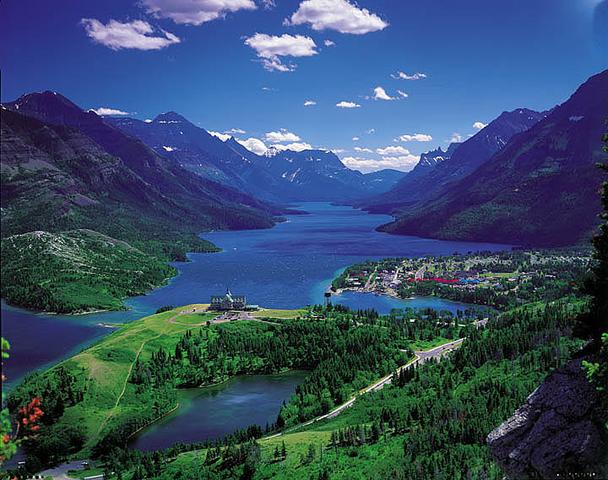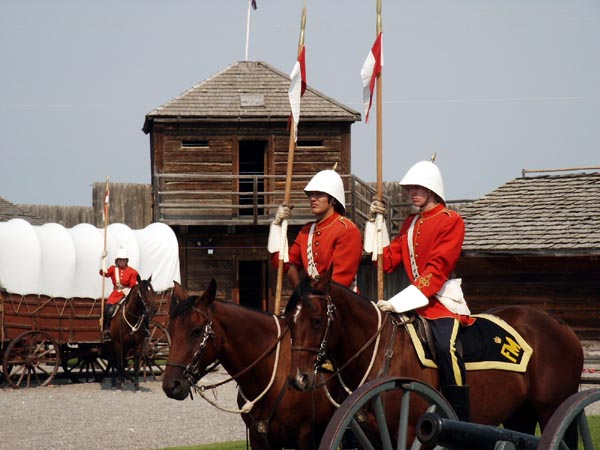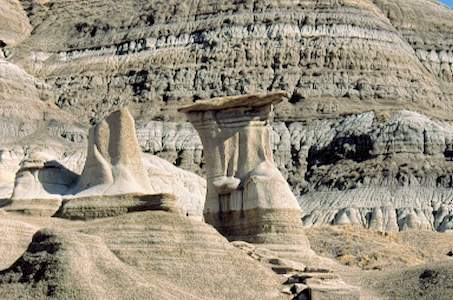The area has a diverse range of ecosystems from native prairie, foothills, badlands, rivers, lakes and mountains, with a very pleasant, semi-arid climate.
Waterton National Park

|
Rugged, windswept mountains rise abruptly out of gentle prairie grassland in spectacular Waterton Lakes National Park. Here, several different ecological regions meet and interact in a landscape shaped by wind, fire, flooding, and abundant plants and wildlife.
The park offers beautiful scenery, wildlife (bald eagles, deer, moose, mountain goats, bighorn sheep, black and grizzly bears, cougars), and recreational opportunities (many hiking trails, horse back riding).
It is also location of the Prince of Wales hotel, a 1927 chalet style building and one of the most photographed hotel.
It offers impressive view on the lakes from the lobby.
UNESCO designated the Waterton-Glacier International Peace Park as a World Heritage Site.
The parc is located 125 km (1h15min drive) southwest of Lethbridge.
|
Fort Macleod

|
The Fort - Museum documents the history of the North West Mounted Police and the First Nations people. It holds place in the original buildings built by the Mounties in 1874. It houses artifacts and information related to the town, North West Mounted Police and the First Nations people.
The Historic Main Street is a designated Provincial Historic Area.
Many of the town's historic buildings and homes are still in use today, and were use as filming locations of the movies Brokeback Mountain and Passchendaele.
The Empress Theatre has been operating since 1912, making it Western Canada's oldest continually operating theatre and one of the city most recognizable attractions.
Fort Mcleod is located 50 km west of Lethbridge.
|
UNESCO World Heritage Site Head-Smashed-In Buffalo-Jump

|
Head-Smashed-In Buffalo Jump is is a cliff formation which native indians historically used in mass killings of plains bison.
It is a UNESCO World Heritage Site and home of a museum of Blackfoot culture.
The interpretive centre is built into the ancient sandstone cliff in naturalistic fashion. It contains five distinct levels depicting the ecology, mythology, lifestyle and technology of Blackfoot peoples within the context of available archaeological evidence, presented from the viewpoints of both aboriginal peoples and European archaeological science.
It is located 18 km northwest of Fort Macleod.
|
Writing-on-Stone Provincial Park

|
Writing-on-Stone Park is a UNESCO World Heritage Site which contains the greatest concentration of rock art on the North American Great Plains. There are over 50 petroglyph sites and thousands of pictographs (paintings).
This park is a sacred landscape that has spiritual significance for the Blackfoot people who hunted & traveled the Great Plains for generations.
It offers hiking trails among hoodoos.
It is located 125 km (1h15min drive) southeast of Lethbridge,
|
Many conference participants may wish to take vacation time before or after the conference to explore these and many other areas.
Lethbridge has a population of over 87,800 (census 2011) and is situated 1 hour north of the US border, with the spectacular Canadian Rocky Mountains 1 hour west of Lethbridge.

|
A prominent landmark in Lethbridge - the High Level Bridge - is an engineering marvel:
it is the longest and highest trestle bridge in the world reaching 5,327.625 feet (1.6km) in length and 314 feet in height.
This impressive structure spans the Oldman River and is within sight from the campus.
|

|
The University of Lethbridge is nestled in the banks of the Oldman River and its beautiful coulee and river valley system in southern Alberta.
This network of glacially derived hills provides many miles of hiking trails and recreational activities for the city.
|

|
The local area's rich history can be explored at Fort Whoop Up and the Sir Alexander Galt Museum.
Originally Fort Hamilton, the fort was known for its whiskey trading post (Whoop-up might be the nickname derived from "to whoop it up").
The Galt Museum is the largest museum in the province south of Calgary. It has a collection of over 20,000 artifacts and 300,000 archival documents and photographs recording the history of Lethbridge and southern Alberta. It attracts over 50,000 visitors every year. |

|
During the Second World War, Japanese Canadians were forcibly relocated from the west coast to areas such as southern Alberta.
The Nikka Yuko Japanese Garden - which means Japanese and Canadian friendship - is a tranquil location in Lethbridge for peace and reflection.
|

|
Lethbridge has a lively art scene:
The Southern Alberta Art Gallery offers a dynamic exhibition schedule featuring contemporary art by renowned local, regional, national, and international artists.
The University of Lethbridge Art Gallery has one of the largest collections in Canada of 19th and 20th century Canadian, American and European art, with over 13,000 pieces including drawing, print making, painting, photography, sculpture and installation. (check out the database)
The main gallery is located behind the Sorel Etrog Moses sculpture on level 6.
The Helen Christou Gallery is located in the library building.
|
|








